Case Report - (2022) Volume 30, Issue 7
Received: 28-Jun-2022, Manuscript No. IPQPC-22-13796; Editor assigned: 30-Jun-2022, Pre QC No. IPQPC-22-13796(Qc); Reviewed: 14-Jul-2022, QC No. IPQPC-22-13796; Revised: 19-Jul-2022, Manuscript No. IPQPC-22-13796(R); Published: 26-Jul-2022, DOI: 10.21767/1479-1064.19.6.66-68
Introduction: The world has been struggling with COVID-19 pandemic for almost 2 years. This health crisis not only affected the medical domain but also has altered the lives of millions of individuals worldwide. The novel coronavirus has been continuously astonishing the scientists with its aggressiveness and multiple presentations. Initially, most patients were expected to present with respiratory symptoms, but the COVID-19 virus took all the medical staff beyond expectations and targeted most human body systems and organs. Many articles are continuously reporting the presence of a wide range of clinical manifestations.
Case description: A two month old baby girl, previously healthy, was referred to our pediatric clinic for an erythematous rash that appeared on her trunk and extremities. This was accompanied with edema of her extremities and a high grade fever that preceded the appearance of the rash by two days. Workup showed a positive COVID-19 infection which was considered the underlying cause after exclusion of any other possible disorder. The rash resolved spontaneously with the end of COVID-19 infection.
Discussion: Although respiratory and gastroenteric symptoms are the most widely known presentations of COVID-19 infection, day after day new manifestations are being documented worldwide. These includes dermatologic signs that are usually self-limited and disappear by the end or soon after the end of the infection.
Conclusion: More studies must be conducted on the SRAS-CoV-2 virus to better understand the reason behind the different manifestations in different individuals. The only solution for this virus so far appears to be vaccination that will distribute immunity throughout the society and eliminate the virus spreading.
COVID-19; Hemorrhagic edema; Infant; Rash
The World Health Organization has declared COVID-19 infection a pandemic in March 2020, and since then, the world has been in a battle with this virus that rendered around 106 million people with varying degree of infections and about 2 million deaths.
COVID-19 virus is one of the Coronaviridea family and the culprit for the acute respiratory syndrome coronavirus-2 (SARSCoV- 2) that has been terrifying the humanity and exhausting the medical sector. The knowledge about this virus and its manifestations has evolved greatly. Indeed, the initial focus was on the respiratory symptoms. The classically described symptoms were mainly pulmonary included cough, dyspnea, respiratory distress that all were often associated with fever, dyspnea, malaise, muscle pain. Extrapulmonary manifestations were also described and a broad variety of other systematic symptoms pertaining to the digestive, hematologic and urinary systems [1]. COVID-19 infection has caused a wide diversity of skin manifestations where several case reports around the world have described cutaneous lesions associated with COVID-19 infection such as chilblains like acral rash, vasculitis, urticaria, morbilliform rash, viral exanthema and others. The cutaneous manifestations seem to be challenging for physicians and dermatologists [2].
In the pediatrics age group, erythema multiforme and chilblains are the two most common skin manifestations that have been increasingly seen in children diagnosed with COVID-19 [3].
We report a case of 2 months infant who presented with skin rash followed by fever, with no respiratory symptoms, workup revealed positive PCR for COVID-19 virus.
A previously healthy two month old baby girl is a product of normal vaginal delivery at full term gestation with no perinatal or postnatal complications. She is a breastfed well followed baby belonging to a middle class family. The baby presented to our clinic accompanied by her parents one day after she developed rash and edema of the extremities. Detailed history showed no familial congenital disorders of hemostasis or other diseases. Parents told us that there was no medication consumption by the mother or the baby. Also, there were no pets at home and no history of recent vaccination. Parents denied any possibility of trauma but they admitted that the infant stayed in contact with them during their recent COVID-19 virus infection without being isolated. They confirmed their infection by two positive nasopharyngeal PCRs done 20 days ago and other negative ones done one week ago. They also mentioned that the baby had two episodes of high grade fever that took place two days prior to the appearance of the rash. The fever was not accompanied with respiratory symptoms and subsided spontaneously without the need of any medication. Thus, a nasopharyngeal PCR was done and detected the presence of SARS-CoV-2 viral RNA.
The baby was not feeding well according to the parents. The vital signs of the infant were within the normal range for her age. On physical examination, patient was active with normal reflexes and had good skin perfusion with only mild signs of dehydration. Auscultation of the chest revealed clear lungs with good air entry on both sides and no audible murmurs. Her abdomen was soft and her fontanelles were neither bulging nor depressed. The skin rash which according to the family started suddenly on the acral areas then progressed rapidly to the extremities and trunk comprised of lesions that were erythematous with circular target shape. The patient had mild, non-pitting, non-tender facial and acral edema (Figures 1-4).
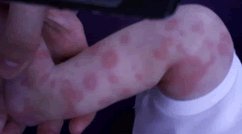
Figure 1: Right leg showing circular target erythematous skin lesions
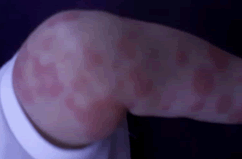
Figure 2: Left leg showing circular target shaped erythematous skin lesions with some coalescence
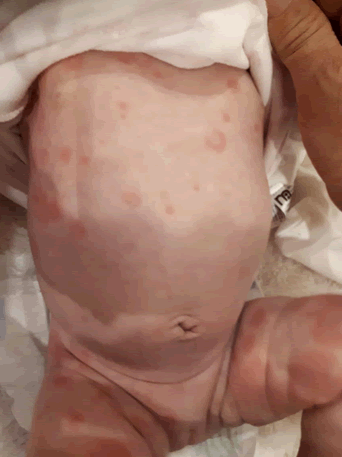
Figure 3: Abdominal side of the trunk showing circular erythematous target skin lesions
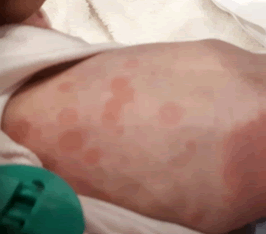
Figure 4: Back side of the trunk showing target shaped circular erythematous lesion
The patient was admitted due to her low oral intake for hydration and for further workup. Her labs on admission showed thrombocytosis in addition to elevation of ESR, C-reactive protein and ferritin (Table 1).
Table 1: Laboratory results.
| Test | Result |
|---|---|
| Haemoglobin (g/L) | 10.3 |
| White blood cells (cu/mm3) | 16,170 |
| Haematocrit (%) | 30.9 |
| Mean cell volume (fL) | 89.2 |
| Platelets (cu/mm3) | 865000 |
| Neutrophil (%) | 47 |
| Lymphocyte (%) | 48 |
| INR | 1.2 |
| SGPT (IU/L) | 33 |
| Lipase (IU/L) | 117 |
| Sodium (mEq/L) | 139 |
| Potassium (mEq/L) | 5.2 |
| HCO3 (mEq/L) | 18 |
| Creatinine (μmol/L) | 0.5 |
| CRP (mg/dL) | 10.3 |
| ESR (mm/H) | 51 |
| Ferritin (ng/mL) | 337 |
| Albumin (g/L) | 38 |
| INR | 1 |
| PTT (seconds) | 35 |
Samples for culture and analysis were taken for her urine, stool, cerebrospinal fluid and blood to rule out any occult infection despite the fact that the fever subsided spontaneously two days prior to presentation. No medications were started because the diagnosis was still not clear. All culture samples came back negative few days later.
Below in Figure 5, all of the common differential diagnosis of pediatric patients presenting with rash were excluded through laboratory tests and history. For example, all of the hematologic disorders were excluded by the normal value of INR and PTT. Regarding the edema, a cardiac echocardiography was done to rule out any insufficiency in the cardiac muscle and came back normal with no evidence of valve abnormalities and with 70% ejection fraction. Also, no hypoalbuminemia was detected so renal and hepatic disorders were excluded.
Finally, we decided to perform a skin biopsy because the clinical course was very suggestive for acute hemorrhagic edema of infancy. The pathologic examination of the biopsy came back confirming our diagnosis and the patient was discharged home without any medications. A scheduled follow up clinic visit was done one week later. There was a complete resolution of the skin lesions without the need for any treatment (Figure 5).
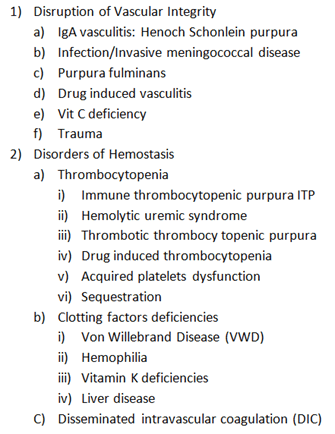
Figure 5: Differential diagnosis of pediatric patient presenting with rash
Acute hemorrhagic edema of infancy (AHEI) which was first described by Snow in 1913 is a rare cutaneous leukocytoclastic vasculitis [4]. Its etiology and pathophysiology is unknown although certain hypothesis supports immune complex mediated vasculitis of cutaneous small vessels. This hypothesis is supported by the fact that most of the cases are preceded by history of infection, immunization and medication exposure.
The diagnosis of AHEI is usually a clinical one without the need for biopsy for confirmation. Four criteria were suggested by Krause et al in 1996 for the confirmation of AHEI. First, the patient must be younger than 2 years of age. Second, the skin lesions must be purpuric or ecchymotic target like lesions with edema of the face or the head and may or may not be associated with mucosal manifestations. Third criterion is the absence of a systemic disease or visceral involvement. The last condition is the spontaneous resolving of the rash in days or few weeks [5]. All of the above criteria are applicable to the above described case.
There are no specific laboratory findings for AHEI although thrombocytosis as in the case described above have been reported repetitively in the literature and it may be reflecting the underlying inflammatory process.
No specific treatment is recommended in the literature because in most cases the disease is self-limited although some clinicians suggest the use of anti-histamine and topical corticosteroids to decrease the severity of the cutaneous lesions.
COVID-19 infection which is surprising the medical field specialists every day can be metaphorically called a syndrome because it is affecting all the body systems and even the psychiatric and mental side of the patients. Some suggest that this is because the virus is a multi-potent one which has no similar virus in the known human history. Others explain that due to the genetic variety within the human kind, different bodies respond in multiple ways to the same viral infection. Although the clinical picture of AHEI might frighten the patient’s family, it is self-limited and resolves spontaneously. An important point to end our case by is that even in the absence of respiratory symptoms of COVID-19, the cutaneous lesions during this pandemic must guide the clinician to a possible underlying SARSCoV- 2 infection since in many cases the dermatologic manifestations are the only presenting signs.
[Google Scholar] [PubMed]
[Crossref] [Google Scholar] [PubMed]
[Crossref] [Google Scholar] [PubMed]
[Crossref] [Google Scholar] [PubMed]
Citation: Dirani FA, Kawtharany B, Diab R, Al-Hajj M, El-Hajj R (2022) COVID-19 Presenting Solely as Acute Hemorrhagic Edema of Infancy. Qual Prim Care. 30.41825
Copyright: © 2022 Dirani FA. This is an open-access article distributed under the terms of the Creative Commons Attribution License, which permits unrestricted use, distribution, and reproduction in any medium, provided the original author and source are credited